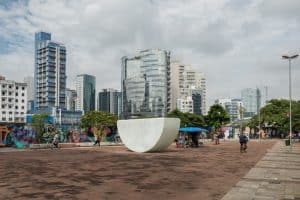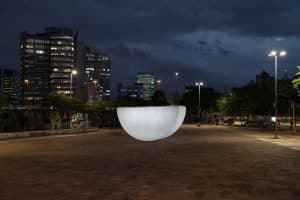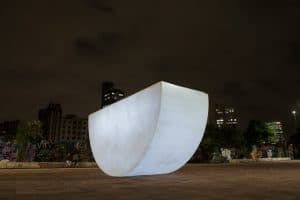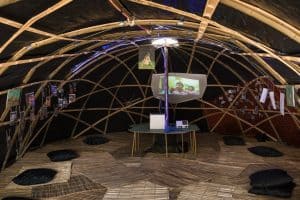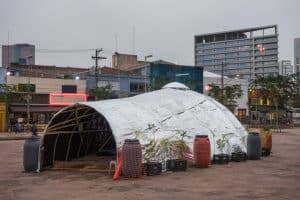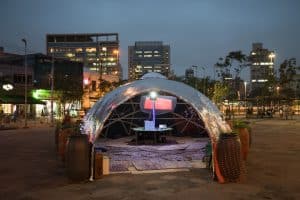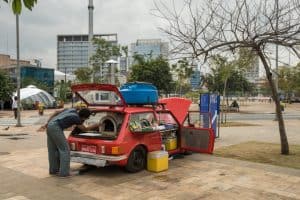URBE – PUBLIC ART EXHIBITION – EDITION 3
After investigating the Center and Bom Retiro in the first two exhibitions (2012 and 2016), URBE – Public Art Exhibition – Edition 3 takes place in Largo da Batata, in Pinheiros. The Exhibition, curated by Felipe Brait and Reinaldo Botelho, has an extensive activation program for fifteen days, with the site specific works of three guest artists – Estela Sokol, LiveNoiseTupi and OPAVIVARÁ! Collective –, an agenda of workshops, a circuit of talks and a itinerary of walks through the works and the neighborhood.
The diversity in the artistic languages, from sculpture to installation, through technology and interactivity, reinforces the Exhibition’s commitment to articulate a multifaceted environment where the public can experience the conceptual fields of art and reflect on contemporary urban space, having the city as a starting point.
OBRAS / ARTISTAS
Sem Título (Greta Garbo), 2018 – by Estela Sokol
Greta Garbo, 2018 – by Estela Sokol
Greta Garbo is a resin sculpture and self-sufficient electrical processes built using a photovoltaic system with diffused lighting. Its implantation has an aesthetic dimension that involves the logic of the senses and relates to the space creating new perceptions and affections in the landscape. The subtle juxtaposition of the volume to the plane maintains the integration with the whole and lets it glimpse contrasts in the sonorous-visual textures, between noises, absences, silences and rest. The sculpture is a semi-spherical segment of two parallel planes and its materiality evokes stability and constancy. In confronting chaos – place of all forms and dissimilarities – it imposes a transition by default of the visual field of the observer, which supposes and deduces a counterpart – sometimes present, sometimes absent.
Estela Sokol (1979, São Paulo)
The light and the color are central elements in the work of Estela Sokol. Color not seen as pigment, but as light. Color that invades space and floods it. The artist produces sculptures, paintings, and photographs. She has held several exhibitions in Brazil and abroad. She has received several awards, such as a residence at Aircube (Linz, Austria), participated in exhibitions of artists abroad, the Fundação Bienal de São Paulo, and the “Temporada de Projetos Paço das Artes”. She has works at the Embassy of Brazil in London.
Apanoesh (Abrigo de Proteção em Ambiente Natural e Observatório de Entorno para a Sobrevivência Humana), 2018 – by LiveNoiseTupi
Apanoesh (Protection Shelter in Natural Environment and Surroundings Observatory for Human Survival), 2018 – by LiveNoiseTupi
Apanoesh is an immersive interactive installation that starts from a dystopic reality, in a post-nuclear fictional context, where the public makes contact with a complex process of composition of transmedia storytelling within a universe of combinations between futuristic and ancestral knowledge. The process, based on a “temporary architecture”, is conducted by the LiveNoiseTupi Collective and activates an environment of historical conjunction (from a reference to the Tupi Indians, the first inhabitants of the place) combined with technological elements present in our everyday life and seeking to awaken a feeling of decolonization through their interactivity.
LiveNoiseTupi
LiveNoiseTupi is a collective of collaborative multimedia performance. We use open source and do-it-yourself tools to build immersive interactive and audio-visual environments. The goal of our work is to play with the boundaries between technologies and modern and ancestral themes to enrich sensory experiences, where the participant can and should interact to modify the dynamics of space. We have already presented with formations and diverse guests for audiences in Zagreb, Ljubljana, London, Marseille, São Paulo, Belo Horizonte, Salvador, Curitiba and Porto Alegre.
Brasa Ilha, 2018 – by OPAVIVARÁ!
Brasa Ilha, 2018 – de OPAVIVARÁ!
From the appropriation and the conversion of a car into a kitchen of public use, the OPAVIVARÁ! Collective seeks to activate subjective processes of contact and interaction with a work of public art. Isolating and removing the first meaning of an object refers to a ready-made process, its reuse applies a new feature where a provocative look hovers. Installed next to the church, the work finds resonance with the public rest benches in format of relational installation. Participants will be able to cook food creating a direct relationship with the work.
OPAVIVARÁ! (Rio de Janeiro)
OPAVIVARÁ! is an art collective that develops actions in the city’s public places, galleries, and cultural institutions, proposing inversions of the modes of occupation of the urban space, through the creation of relational devices that provide collective experiences. Since its establishment in 2005, the group has been actively participating in the contemporary art scene.
